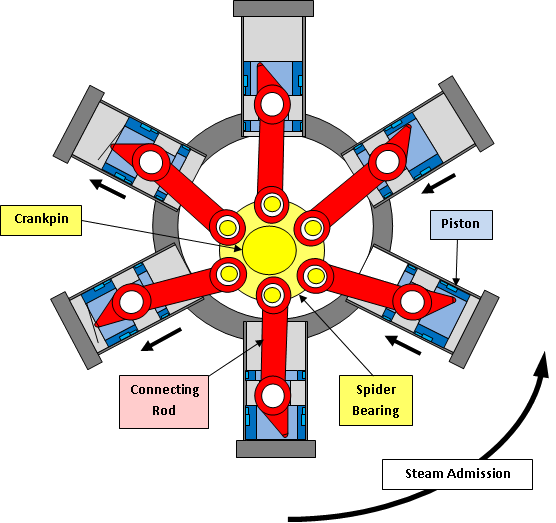|
Energetically Autonomous Tactical Robot
The Energetically Autonomous Tactical Robot (EATR) was a project by Robotic Technology Inc. (RTI) and Cyclone Power Technologies Inc. to develop a robotic vehicle that could forage for plant biomass to fuel itself, theoretically operating indefinitely. It was a concept developed between 2003 and 2009 as part of the DARPA military projects for the United States military. The project elicited some internet and media rumors after news circulated that the robot would (or at least could) ingest human remains. Cyclone Power Technologies stated that animal or human biomass was not intended to be used in the ''waste heat'' combustion engine of the robot, Press release, RTI Inc. (2009 July 16)"Press Release" ''Cyclone Power Technologies Responds to Rumors about “Flesh Eating” Military Robot'', pp. 1–2. and that sensors would be able to distinguish foraged materials, although the project overview from RTI listed other sources including chicken fat. Power plant The robot was powered by ... [...More Info...] [...Related Items...] OR: [Wikipedia] [Google] [Baidu] |
Biomass
Biomass is plant-based material used as a fuel for heat or electricity production. It can be in the form of wood, wood residues, energy crops, agricultural residues, and waste from industry, farms, and households. Some people use the terms biomass and biofuel interchangeably, while others consider biofuel to be a ''liquid'' or ''gaseous'' fuel used for transportation, as defined by government authorities in the US and EU. The European Union's Joint Research Centre defines solid biofuel as raw or processed organic matter of biological origin used for energy, such as firewood, wood chips, and wood pellets. In 2019, biomass was used to produce 57 EJ (exajoules) of energy, compared to 190 EJ from crude oil, 168 EJ from coal, 144 EJ from natural gas, 30 EJ from nuclear, 15 EJ from hydropower, hydro and 13 EJ from wind power, wind, solar power, solar and geothermal energy, geothermal combined. Approximately 86% of modern bioenergy is used for heating applications, with 9% used for tra ... [...More Info...] [...Related Items...] OR: [Wikipedia] [Google] [Baidu] |
DARPA
The Defense Advanced Research Projects Agency (DARPA) is a research and development agency of the United States Department of Defense responsible for the development of emerging technologies for use by the military. Originally known as the Advanced Research Projects Agency (ARPA), the agency was created on February 7, 1958, by President Dwight D. Eisenhower in response to the Soviet launching of Sputnik 1 in 1957. By collaborating with academia, industry, and government partners, DARPA formulates and executes research and development projects to expand the frontiers of technology and science, often beyond immediate U.S. military requirements.Dwight D. Eisenhower and Science & Technology, (2008). Dwight D. Eisenhower Memorial CommissionSource '' The Economist'' has called DARPA the agency "that shaped the modern world," and pointed out that " Moderna's COVID-19 vaccine sits alongside weather satellites, GPS, drones, stealth technology, voice interfaces, the personal comput ... [...More Info...] [...Related Items...] OR: [Wikipedia] [Google] [Baidu] |
United States Military
The United States Armed Forces are the military forces of the United States. The armed forces consists of six service branches: the Army, Marine Corps, Navy, Air Force, Space Force, and Coast Guard. The president of the United States is the commander-in-chief of the armed forces and forms military policy with the Department of Defense (DoD) and Department of Homeland Security (DHS), both federal executive departments, acting as the principal organs by which military policy is carried out. All six armed services are among the eight uniformed services of the United States. From their inception during the American Revolutionary War, the U.S. Armed Forces have played a decisive role in the history of the United States. They helped forge a sense of national unity and identity through victories in the First Barbary War and the Second Barbary War. They played a critical role in the American Civil War, keeping the Confederacy from seceding from the republic and preserving ... [...More Info...] [...Related Items...] OR: [Wikipedia] [Google] [Baidu] |
Wired (magazine)
''Wired'' (stylized as ''WIRED'') is a monthly American magazine, published in print and online magazine, online editions, that focuses on how emerging technologies affect culture, the economy, and politics. Owned by Condé Nast, it is headquartered in San Francisco, California, and has been in publication since March/April 1993. Several spin-offs have been launched, including ''Wired UK'', ''Wired Italia'', ''Wired Japan'', and ''Wired Germany''. From its beginning, the strongest influence on the magazine's editorial outlook came from founding editor and publisher Louis Rossetto. With founding creative director John Plunkett, Rossetto in 1991 assembled a 12-page prototype, nearly all of whose ideas were realized in the magazine's first several issues. In its earliest colophon (publishing), colophons, ''Wired'' credited Canadian media theorist Marshall McLuhan as its "patron saint". ''Wired'' went on to chronicle the evolution of digital technology and its impact on society. ' ... [...More Info...] [...Related Items...] OR: [Wikipedia] [Google] [Baidu] |
Robot
A robot is a machine—especially one programmable by a computer—capable of carrying out a complex series of actions automatically. A robot can be guided by an external control device, or the control may be embedded within. Robots may be constructed to evoke human form, but most robots are task-performing machines, designed with an emphasis on stark functionality, rather than expressive aesthetics. Robots can be autonomous or semi-autonomous and range from humanoids such as Honda's ''Advanced Step in Innovative Mobility'' ( ASIMO) and TOSY's ''TOSY Ping Pong Playing Robot'' ( TOPIO) to industrial robots, medical operating robots, patient assist robots, dog therapy robots, collectively programmed ''swarm'' robots, UAV drones such as General Atomics MQ-1 Predator, and even microscopic nano robots. By mimicking a lifelike appearance or automating movements, a robot may convey a sense of intelligence or thought of its own. Autonomous things are expected to proliferat ... [...More Info...] [...Related Items...] OR: [Wikipedia] [Google] [Baidu] |
Cyclone Waste Heat Engine
The Cyclone Waste Heat Engine (WHE) is a small steam engine developed to produce power from steam created from waste heat. It is an offshoot of the development of the Cyclone Mark V Engine by the company Cyclone Power Technologies of Pompano Beach, Florida. The original versions were designed by inventor Harry Schoell, founder of Cyclone Power Technologies and the later versions have been designed by the Ohio State University Center for Automotive Research (OSU-CAR). In July 2014, Cyclone Power Technologies separated its waste heat engine product into the separate WHE Generation Corporation,Quarterly Report for the quarterly period ended June 30, 2014, filed with the Securities and Exchange Commission. Retrieved from https://www.sec.gov/Archives/edgar/data/1442711/000139843214000332/cypw20140630_10q.htm which does business under the trade name Q2Power, Inc., of Lancaster, Ohio. Engine construction and operation The Cyclone Waste Heat Engine (WHE) is a single-acting, Uniflow ... [...More Info...] [...Related Items...] OR: [Wikipedia] [Google] [Baidu] |
Rankine Cycle
The Rankine cycle is an idealized thermodynamic cycle describing the process by which certain heat engines, such as steam turbines or reciprocating steam engines, allow mechanical work to be extracted from a fluid as it moves between a heat source and heat sink. The Rankine cycle is named after William John Macquorn Rankine, a Scottish polymath professor at Glasgow University. Heat energy is supplied to the system via a boiler where the working fluid (typically water) is converted to a high pressure gaseous state (steam) in order to turn a turbine. After passing over the turbine the fluid is allowed to condense back into a liquid state as waste heat energy is rejected before being returned to boiler, completing the cycle. Friction losses throughout the system are often neglected for the purpose of simplifying calculations as such losses are usually much less significant than thermodynamic losses, especially in larger systems. Description The Rankine cycle closely describe ... [...More Info...] [...Related Items...] OR: [Wikipedia] [Google] [Baidu] |
Military Robots
Military robots are autonomous robots or remote-controlled mobile robots designed for military applications, from transport to search & rescue and attack. Some such systems are currently in use, and many are under development. History Broadly defined, military robots date back to World War II and the Cold War in the form of the German Goliath tracked mines and the Soviet teletanks. The MQB-1 Predator drone was when "CIA officers began to see the first practical returns on their decade-old fantasy of using aerial robots to collect intelligence". The use of robots in warfare, although traditionally a topic for science fiction, is being researched as a possible future means of fighting wars. Already several military robots have been developed by various armies. Some believe the future of modern warfare will be fought by automated weapons systems. The U.S. military is investing heavily in the RQ-1 Predator, which can be armed with air-to-ground missiles and remotely ope ... [...More Info...] [...Related Items...] OR: [Wikipedia] [Google] [Baidu] |
Biomass
Biomass is plant-based material used as a fuel for heat or electricity production. It can be in the form of wood, wood residues, energy crops, agricultural residues, and waste from industry, farms, and households. Some people use the terms biomass and biofuel interchangeably, while others consider biofuel to be a ''liquid'' or ''gaseous'' fuel used for transportation, as defined by government authorities in the US and EU. The European Union's Joint Research Centre defines solid biofuel as raw or processed organic matter of biological origin used for energy, such as firewood, wood chips, and wood pellets. In 2019, biomass was used to produce 57 EJ (exajoules) of energy, compared to 190 EJ from crude oil, 168 EJ from coal, 144 EJ from natural gas, 30 EJ from nuclear, 15 EJ from hydropower, hydro and 13 EJ from wind power, wind, solar power, solar and geothermal energy, geothermal combined. Approximately 86% of modern bioenergy is used for heating applications, with 9% used for tra ... [...More Info...] [...Related Items...] OR: [Wikipedia] [Google] [Baidu] |
Robots Of The United States
"\n\n\n\n\nThe robots exclusion standard, also known as the robots exclusion protocol or simply robots.txt, is a standard used by websites to indicate to visiting web crawlers and other web robots which portions of the site they are allowed to visit.\n\nThis relies on voluntary compliance. Not all robots comply with the standard; email harvesters, spambots, malware and robots that scan for security vulnerabilities may even start with the portions of the website where they have been told to stay out.\n\nThe \"robots.txt\" file can be used in conjunction with sitemaps, another robot inclusion standard for websites.\n History\nThe standard was proposed by Martijn Koster, when working for Nexor in February 1994\n on the ''www-talk'' mailing list, the main communication channel for WWW-related activities at the time. Charles Stross claims to have provoked Koster to suggest robots.txt, after he wrote a badly-behaved web crawler that inadvertently caused a denial-of-service attack on Kost ... [...More Info...] [...Related Items...] OR: [Wikipedia] [Google] [Baidu] |
2000s Robots
S, or s, is the nineteenth letter in the Latin alphabet, used in the modern English alphabet, the alphabets of other western European languages and others worldwide. Its name in English is ''ess'' (pronounced ), plural ''esses''. History Origin Northwest Semitic šîn represented a voiceless postalveolar fricative (as in 'ip'). It originated most likely as a pictogram of a tooth () and represented the phoneme via the acrophonic principle. Ancient Greek did not have a phoneme, so the derived Greek letter sigma () came to represent the voiceless alveolar sibilant . While the letter shape Σ continues Phoenician ''šîn'', its name ''sigma'' is taken from the letter ''samekh'', while the shape and position of ''samekh'' but name of ''šîn'' is continued in the '' xi''. Within Greek, the name of ''sigma'' was influenced by its association with the Greek word (earlier ) "to hiss". The original name of the letter "sigma" may have been ''san'', but due to the complic ... [...More Info...] [...Related Items...] OR: [Wikipedia] [Google] [Baidu] |





